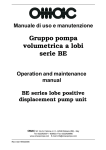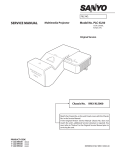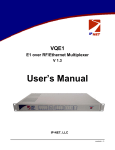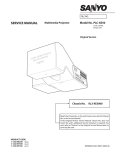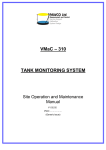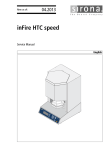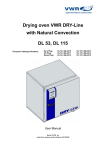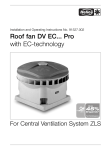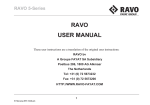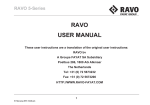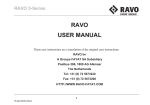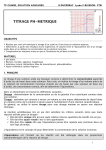Download F&W Instructions - Vent-Axia
Transcript
MX type roof extract fan instructions for use ® ® Table of Contents 1. Foreword ………………………………………page 3 2. Guarantee and liability 2.1 Guarantee conditions …………………………page 3 2.2 Liability ………………………………………page 3 11. 11.1 11.2 11.3 Malfunctions Malfunction tables …………………………page 22-24 Replacement of components …………………page 25 Logbook ………………………………………page 26 12. EC declaration of conformity …………………page 27 3. Safety 3.1 General safety regulations ……………………page 4 3.2 Pictograms used ………………………………page 4 4. Technical data 4.1 General specifications …………………………page 5 4.2 Dimensioned drawings …………………………page 6 5. 5.1 5.2 5.3 5.4 5.5 Speed control MX without speed control ………………………page 7 Speed control of one MX fan ……………………page 7 Speed control of a number of MX fans …………page 7 RSC servo contact ………………………………page 7 LTG temperature control ………………………page 7 6. 6.1 6.2 6.3 6.4 Communication Reading and adjustment ………………………page 8 VU Control Unit …………………………………page 8 Communication with laptop/PC …………………page 8 MX network ……………………………………page 8 7. 7.1 7.2 7.3 7.4 Installation Installation conditions …………………………page 9 Transport, storage and unpacking ………………page 9 Verification of delivery …………………………page 9 Installation ……………………………………page 9 8. 8.1 8.2 8.3 Electrical connection Controls clamp strip …………………………page 10 Wiring upon delivery …………………………page 10 Relationship between speed and voltage at 0-10 V controls input ………………page 11 8.4 Wiring diagrams……………………………page 12-16 9. Adjustment 9.1 Summary of MX settings ………………………page 17 9.2 MX network: addressing, settings and copying of settings ………………page 18 9.3 Control of air volume …………………………page 19 9.4 Measuring report………………………………page 20 10. Inspection and maintenance 10.1 Inspection and maintenance ……………… page 21-22 2 ® 1. Foreword / 2. Guarantee and liability This installation manual contains instructions for the installation and maintenance of the MX roof extract fan. This manual applies to the following types: MX 10/10 MX 20/20 MX 30/10 MX 30/20 Read this manual carefully before commencing installation or maintenance of the fan. This manual contains information required for safe and optimal installation of the MX roof extract fan. It is also intended as a reference for service and maintenance work, in order that this can be carried out in a sound manner. 2.1 Guarantee conditions Applicable only to products installed and used in the United Kingdom. For details of guarantee outside the United Kingdom contact your local supplier. Vent-Axia guarantees its products for two years from the date of purchase against faulty material or workmanship. In the event of any part being found to be defective, the product will be repaired, or at the Company's option replaced, without charge, provided that the product: 1) has been installed and used in accordance with the instructions given wfth each unit. 2) has not been connected to an unsuitable electricity supply. (The correct electricity supply voltage is shown on the product rating label attached to the unit.) 3) has not been subjected to misuse, neglect or damage. 4) has not been modified or repaired by any person not authorised by the company. IF CLAIMING UNDER TERMS OF GUARANTEE please return the complete product, carriage paid to your original supplier or nearest Vent-Axia Centre, by carrier or personal visit. Please ensure that it is adequalely packed and accompanied by a letter clearly marked 'Guarantee Claim' stating the nature of the fault and providing evidence of date and source of purchase. The guarantee is offered to you as an extra benefit, and does not affect your legal rights. 2.2 Liability The MX has been designed for extraction of (polluted) air, which is diagonally exhausted. Any other application is seen as ‘inappropriate use’ and can result in damage to the MX or personal injury, for which the manufacturer cannot be held liable. Work to be carried out on the fan may only be carried out by a qualified mechanical electrical engineer. The manufacturer is not responsible for any damage derived from: • non compliance with the safety, operating and maintenance instructions in this guide; • the use of components not supplied by the manufacturer; • normal wear and tear. Safety It is important that you heed the safety instructions given below, for sensible use of the MX roof extract fan but also for your own safety and that of other people. 3 ® 3. Safety 3.1 General safety regulations • Always comply with the safety regulations and instructions given in this manual. • Make sure that (parts of) the fan not (yet) anchored and tools cannot fall off the roof and cause damage or personal injury. • When the fan is completely or partly dismantled, make sure nobody can touch rotating or live parts. • Do not leave a (partly) dismantled fan which is connected to the power supply, unattended. • Make sure that parts which conduct electricity do not become wet. • The fan must be fitted in such a manner that there is no risk of anybody touching the side of the fan which does not have a protective screen (see EN 294). 3.2 Pictograms used The following pictograms may be used in the manual. Point of attention 4 ® 4. Technical data MX 10/10 ∆ Pst Pa (N/m2) 400 Speed rpm = MX 350 1800 Current Power Noise level consumption consumption deliv suctionsuction*cos. A Wel dB(A) dB(A) dB(A) ϕ 300 1600 250 max. power cons. 200 1400 150 1200 1000 100 800 50 max. sound pressure level 600 1800 1600 1400 1200 1000 800 600 400 0,76 0,55 0,39 0,26 0,17 0,12 0,09 0,07 174 125 87 60 39 27 19 12 57 54 50 46 41 36 30 24 72 70 66 63 58 56 49 41 63 61 58 55 51 49 42 35 0,99 0,99 0,99 0,99 0,99 0,98 0,92 0,75 400 0 0 500 1000 1500 2000 m3/h MX 20/10 ∆ Pst Pa (N/m2) 500 = MX Speed rpm 1600 400 max. power cons. 1400 300 1200 200 1000 800 100 max. sound pressure level 600 400 1600 1400 1200 1000 800 600 400 Current Power Noise level consumption consumption deliv suctionsuction*cos. A Wel dB(A) dB(A) dB(A) ϕ 1,80 1,16 0,73 0,44 0,25 0,14 0,09 409 266 169 100 57 31 17 62 58 53 48 42 36 28 77 74 69 65 59 55 48 64 62 57 54 49 45 39 0,99 0,99 0,99 0,99 0,99 0,96 0,82 0 0 400 800 1200 2000 1600 2400 2800 3600 m3/h 3200 MX 30/10 ∆ Pst Pa (N/m2) 300 = MX Speed rpm 1000 250 max. power cons. 900 200 800 150 700 100 600 500 50 max sound pressure level 400 1000 900 800 700 600 500 400 Current Power Noise level consumption consumption deliv suctionsuction*cos. A Wel dB(A) dB(A) dB(A) ϕ 1,30 0,92 0,64 0,44 0,29 0,19 0,13 297 217 148 103 67 44 28 56 52 49 46 42 37 33 71 68 65 62 60 55 52 61 57 56 53 50 46 43 0,99 0,99 0,99 0,99 0,99 0,99 0,94 0 0 500 1000 1500 ∆ Pst Pa (N/m2) 2000 2500 3000 3500 4000 m3/h MX 30/20 600 = MX 1400 500 max. power cons. Speed rpm 400 1200 300 1000 200 800 max. sound pressure level 600 100 400 1400 1200 1000 800 600 400 Current Power Noise level consumption consumption deliv suctionsuction*cos. A Wel dB(A) dB(A) dB(A) ϕ 3,34 2,03 1,18 0,65 0,32 0,12 761 462 269 147 72 28 64 61 57 51 44 36 78 75 71 66 60 51 67 64 60 55 49 41 0,99 0,99 0,99 0,98 0,98 0,98 0 0 1000 2000 3000 4000 5000 m3/h 5 ® 4. Technical data 4.2 Dimensioned drawings øD F E A (inw.) ø10(4x) B G H type of fan MX 10 MX 20 MX 30 type of acc* A B D 330 460 330 575 450 580 450 708 535 665 535 863 * The coding indicates the gauge of the fastening holes. 6 E F 60 473 60 540 60 601 G H 44 196 48 241 64 302 ® 5. Speed control Various regulators can be fitted in order to regulate the speed. A distinction is made between regulation of one fan or regulation of a number of fans at the same time. 5.1 MX without speed control When the MX is delivered, it operates at the maximum set speed when connected to the power supply. This capacity is given on the label on the top of the controls. Remove the LUS3 from the clamp strip of the controls (see chapter 8.2) and the MX will operate at the minimum speed. In order to operate the fan at a different speed, this speed must be set using the Control Unit VU (see chapter 6.1). 5.2 Speed control of one MX fan The following regulators are available for speed control of one MX fan. SAG 0-M Rotating switch for continuous adjustment of the speed. (see diagram 2 page 13 & SAG 0-M leaflet) SAG 0-5 Rotating switch for adjustment of the speed in five positions. (see diagram 2 page 13 & SAG 0-5 leaflet) SAG 0-2 Rotating switch for adjustment of the speed in two positions. (see diagram 2 page 13 & SAG 0-2 leaflet) 5.3 Speed control of a number of MX fans The following regulators are available for speed control of a number of MX fans. VG 31 5.4 RSC servo contact The servo contact can be used for the parallel switching of another system component, a valve for example. The servo contact is supplied in a separate housing which can be fitted under the cover of the MX, for example. 5.5 LTG temperature control The LTG is a temperature regulator with which the MX speed can be continuously adjusted, depending on the temperature. The temperature is measured using the supplied temperature gauge. The temperature is set between 20°C and 50°C using a rotation knob on the housing. Rotation of a potentio-meter in the housing adjusts the bandwidth between 0.5°C and 10°C. The speed of the MX varies between the minimum and maximum of the set bandwidth. The LTG can also be used in combination with the VG31. One LTG can be used to control a number of fans. cooling or heating There is a choice between ‘cooling’ or ‘heating’. - For cooling, the MX will be speeded up when the temperature increases. A rotation knob on the LTG housing is used to set the temperature, whereby the MX operates at the minimum speed. The MX is speeded up as the temperature rises. The maximum speed is reached at the set temperature + bandwidth. - For heating, the MX will be slowed when the temperature increases. The rotation knob on the LTG housing is used to set the temperature, whereby the MX operates at minimum speed. The MX is speeded up as the temperature drops. The maximum speed is reached at the set temperature - bandwidth. The cooling or heating function can be set using a number of jumpers within the housing. The LTG also includes a jumper which can be used to select that the fan is switched off when it reaches the set temperature. Power supply unit for the parallel control of maximum 31 MX fans. The unit is fed with 230 V AC voltage. Depending on the speed regulation required, the power supply unit is connected to the SAG 0 - M, SAG 0-5 or SAG 0-2. DNG 31 Unit for day/night switching of maximum 31 MX fans. The switching times are set with a timer. A central switch can be used to simultaneously switch all connected fans on and off. The unit is fed with 230 V AC voltage. The DNG 31 can also be used for day/night switching of MX-ZMV. 7 ® 6. Communication For example 6.4 MX network The jumpers in the housing are set to ‘cooling’. Temperature set at 25°C, bandwidth at 4°C. MX fan capacity set at: minimum 40%, maximum 80%. At 25°C, the fan works at 40%, at 25 + 4 = 29°C, the fan works at the maximum capacity. A network of fans can be built, via inter-connection of a number of MX fans using the communication connection. The serial connection of each fan is double, in order to interconnect them. Each fan in the network is programmed with its own address, via the lap-top/PC or the Control Unit. 6.1 Reading and adjustment Besides the direct connection between the lap-top/PC or the Control Unit with the network, reading and adjustment can also take place remotely. From the lap-top/PC, a modem can be used to communicate with an MX network at a different location. The MX network at location must be connected to the telephone net via a modem or other equipment, for this purpose. For more information, refer to the ‘VENT-AXIA Maintenance – Software – Networks – Communication Manual’, available from VENT-AXIA. Each MX is fitted with a connection for the Control Unit VU or a laptop/PC. This connection can be found under the MX cover. Various units can be adjusted and read via this connection, such as: • type of fan and controls; • required capacity and limitations of minimum and maximum capacity; • current speed; • address and group number (for application of MX in a network); • malfunctions. 6.2 VU Control Unit The VU Control Unit allows for direct communication with the MX. Method of operation The plug of the unit is inserted into the MX connection. Once the Control Unit has been switched on, the current data of the MX is shown on the display of the unit. These settings can be changed. Consider the following applications, for example: • adjustment on site or subsequent re-adjustment of the capacity of the MX; • setting an address (MX in network). The unit is supplied in a case with a user’s manual. Also included with the unit is a charging unit for charging in a car (12V) or via a wall socket (230V). 6.3 Communication with laptop/PC The VENT-AXIA Maintenance Software can be used for direct communication between the laptop/PC and MX. An interface is used for connection of the MX to the laptop/PC. The possibilities for adjustment and reading are virtually the same as those for the VU Control Unit. The main difference is that, when communicating with a laptop/PC, the MX settings can be saved as a file. For a list of the options, refer to the ‘VENT-AXIA Maintenance - Software – Networks – Communication Manual’, available from VENT-AXIA. 8 ® 7. Installation 7.1 Installation conditions • The MX must be installed according to the general and locally applicable safety and installation regulations. • The MX must be fitted in such a manner that there is no risk of anybody touching the suction side of the fan (see EN 294). • The permissible temperature of the air to be moved is from -30°C to +80°C. • The fan is designed for continuous operation and must not be switched on and off more frequently than once every five minutes. 7.2 Transport, storage and unpacking • The MX must be transported horizontally. • During storage, the MX must be positioned horizontally. • The fan should preferably be lifted using the recesses in the side of the housing or on the base. • Ensure that the packaging materials are disposed of in an environmentally responsible manner. 7.3 Checking the delivery • The type indication and other fan rating plate information must match that on the order. • The box contains the manual and a bag with mounting bolts and rings, intended for attaching the MX to a mounting curb. 7.4 Installation General • It is vital that the roof construction or foundation on which the MX is to be installed is sufficiently rigid. If it is not rigid enough, undesirable vibrations may occur during operation of the fan. • The fan must be installed using the supplied bolts and rings. Ensure that both the foundation and the surface into which the bolts are screwed are sufficiently strong to retain the fan even under severe weather conditions. • The fan must be mounted horizontally to avoid rain and wind blowing into the fan. The maximum permissible angle of installation is 5° to the horizontal. • Ensure that the four corners of the fan mounting base are level. An unlevel mounting base may result in uneven stress on the fan construction. • The power supply cable, any control cables and possibly a pressure hose can be fed through a tube leading from under the base of the fan to under the hood. This tube is indicated under the hood as ‘supply cable’, see illustration 7.1. A tube to one of the recesses in the corners of the ventilators can be used to feed cables to the operating switch. This is indicated by ‘cable’, see illustration 7.1. supply cable cable ill. 7.1 9 ® 8. Electrical connection 8.1 Controls connection strip The connection strip of the controls is shown below. sensor connection 0-10 V controls input Failure contact make KL2B PE 1 GND 18 V Eist GND U3 10 V Esoll U3 L N RS RS RS RS GND A B A B An U3 KL2A 2nd PC/Control Unit connection PC/Control Unit connection Power supply 230V, 50Hz KL5A KL3B Ö G S G PE2 +15V +15V TW GND GND U4 U4 PTC U4 U4 EN EN H1 H2 H3 KL4 KL3A U KL5B Failure contact release contact break V W KL6 Motor 8.2 Wiring upon delivery • 0 –10 V controls input: for regulation of the speed of the MX using low voltage switches. The MX standard There are three links on the controls connection strip. One or more links may need to be removed in order to connect up control equipment. Refer to the applicable diagrams in chapter 8.4. • LUS1 is used to connect the +10V to the first connector of the release contact. • LUS2 is used to connect the GND to the second connector of the release contact. • LUS3 is used to connect the +10V to the Esoll of the 0-10V controls input. • Release contact: the current at this contact must be 10- 250 volt (AC or DC). When there is no current at the release contact, the fan will not work, even if there is 230 V power supply. • Malfunction contacts: There is a make and break contact. In case of a malfunction, the contact between the two KL3A connectors is closed and between the two KL3B connectors is opened. The reverse situation occurs when there is ‘no malfunction’. • Communication connection: for adjustment and reading of the MX using the VU Control Unit or the laptop/PC. The contact is double: one A/B connection is connected to a sub-D9 connector in the frame, one A/B connector is free and can be used for looping when the MX is included in a network. LUS1 and LUS2 provide current for the release contact. Via LUS3, there is 10V on the Esoll of the 0-10 controls input. The fan will therefore operate at maximum capacity following connection. To WS lus 2 KL2B PE 1 L N GND 18 V Eist GND U3 10 V Esoll U3 lus 3 RS RS RS RS GND An A B A B U3 KL2A lus 1 PC/Control Unit connection 10 KL3B Ö G S G KL3A EN EN KL4 ® 8.3 Relationship between speed and current at 0-10V controls input When connecting regulators, the speed of the MX is controlled by varying the voltage at the 0-10 V controls input. Measurement of the voltage between Esoll and GND connectors of the 0-10V controls input allows for the speed of the fan to be derived from one of the graphs given below. The current between Esoll and GND can be measured both on the MX (two connectors of the 0-10 V controls input) and the switch/regulator connected. Speed (rpm) Capacity (%) 2000 100 1500 75 1000 50 500 0 25 0 2 4 6 8 10 0 Capacity (%) Speed (rpm) 100 500 0 100 75 50 30 2 4 6 8 10 50 500 25 0 2 4 6 8 10 0 0 0 Esoll - GND (V) 0 2 4 6 8 10 Esoll - GND (V) 11 6 8 10 0 n2 n1 75 1000 50 500 25 0 0 2 4 6 8 10 0 V Esoll - GND (V) Min. Capacity 50% and Max. Capacity 70% means 50% at 0 V and 70% at 10 V at the 0-10V controls input. 70% 4 100 Example Capacity [%] 2 SAG 0-2 The minimum and maximum capacity can be adjusted using the VU Control Unit or the laptop/PC. This means that the graphics of the fan change. 0 0 3.8 5.5 Esoll - GND (V) + 10V EN These graphs apply only if the minimum and maximum capacity setting has not been changed. 50% 25 Capacity (%) Speed (rpm) 1500 0 1000 50 1500 0 75 1000 2000 500 100 1500 75 Esoll - GND (V) Capacity (%) Capacity (%) Speed (rpm) 2000 1500 2000 1000 If you wish to adjust an MX 20/10 to two speeds using the SAG 0-2: 750 rpm and 1000 rpm, follow the example below. • Turn the switch to position ‘1’. • Rotate the n1 potentio-meter until the voltage between the GND and Esoll connectors is 3.8 V. This corresponds with 750 rpm, see the characteristic of the MX 20/10 below. • Now turn the switch to position ‘2’. Now rotate the n2 potentiometer until 5.5 V is given, which corresponds with 1000 rpm. 2000 Esoll - GND (V) Speed (rpm) Adjustment example . Esoll GND ® 8. Electrical connection The fan is connected in accordance with the applicable diagram. A number of diagrams may be simultaneously applicable. The fan is class 1 and must be earthed 8.4 Wiring diagrams MX (standard) wiring diagram diagram 1 1 2 RS B RS B RS A KL 2A G 1 KL 3a EN 2 1 EN 2 1 3 L N 3 4 5 WS 12 white 4 2 brown orange KL 1 S KL 4 An GND U3 6 1 G 9 8 1 2 7 6 green / yellow green / yellow 1 RS A N Ö Motor connection 2 brown L KL 3B blue 6 18 V Eist GND 10 V Esoll GND U3 U3 black KL 2B 1 brown red yellow black blue PE1 ® SAG 0-2 / SAG 0-5 / SAG 0-M wiring diagram diagram 2 +10V EN PE1 KL 2B 1 6 Esoll 1 18 V Eist GND 10 V Esoll GND U3 U3 L RS A N 1 2 RS B RS A RS B 6 KL 3B Ö G S G 1 KL 2A KL 1 Motor connection 2 KL 4 An GND U3 1 GND KL 3a EN 2 1 EN 2 remove these links VG 31 wiring diagram diagram 3 Use VG 31 in combination with switch SAG SAG 0-2 SAG 0-5 SAG 0-M 3 x 0.75 mm2 Max. 31 MXs GND Esoll EN + 10 V +10V EN Esoll GND Switches PE1 KL 2B 1 6 1 E GND 18 V Eist GND U3 10 V soll U3 L VG 31 1 N L 203 V 50 Hz KL 1 10 v GND GND EN EN Esoll Esoll RS A N 2 RS B RS A RS B KL 2A Ö Motor connection 2 G KL 4 An GND U3 6 1 KL 3B S 1 G KL 3a EN 2 1 EN 2 remove these links. 13 ® 8. Electrical connection DNG 31 wiring diagram diagram 4 3 X 0,75 mm2 Max. 31 MXs R1 = speed setting potentio-meter = 1 R2 = speed setting potentio-meter = 2 DNG 31 L N 230 V 50 Hz PE 1 18 V E ist RS A N L 10 V GND GND P1 KL 2B 1 1 2 6 RS B RS A 1 RS B An KL 2A KL 3B Ö G S G 1 EN 2 KL 3A EN EN E soll E soll P2 Motor connection 2 KL 4 GND U3 6 KL 1 1 GND GND 10 V E soll U3 U3 1 EN 2 remove these links. RSC wiring diagram diagram 5 PE1 L KL 2B 1 N 1 2 6 1 KL 3B E GND 18 V Eist GND U3 10 V soll U3 Ö G RS A S G RS B RS A KL 2A KL 4 An GND U3 6 1 KL 1 RS B Motor connection 2 1 KL 3A EN 2 1 EN 2 RSC KL 4-1 KL 6 RSC 250 V/8 A KL 4-2 KL 4-1 WS 5 1 3 L N 14 6 4 2 KL 6 KL 2 M Servo motor KL 4-2 KL 2 Use RSC contact to switch servo motor as soon as the fan is switched on.. ® LTG wiring diagram diagram 6 4 x 0,75 mm2 R=upper temperature setting potentio-meter R7=band width setting potentio-meter U2 PE1 KL2B 1 l RS A N 1 2 1 RS B RS A RS B An 1 KL3B Ö Motor connection 2 G KL4 GND U3 S 6 KL2A KL1 1 EN G KL3A 2 1 EN 2 JP7 SENS remove these links 0,5 Jumpers (removable link) in 4 positions shown below - heating: to JP2, JP4, JP7 - cooling: to JP3, JP5, JP7 - upon reaching the set temperature, the fans must switch on: JP1 to ‘uit’ - upon reaching the set temperature, the fans must continue rotation at minimum speed: JP1 to ‘minimum’ weiß braun 2,5 minimum uit JP1 Esoll 5 EN TP2 10 7,5 JP6 JP4 JP5 JP2 TP1 JP3 TP3 +18V 6 GND GND 10V Esoll U3 U3 18V Eist external sensor Cooling Heating temperature setting 20°C band width 5°C temperature setting 20°C band width 5°C Esoll (V) Esoll (V) (max.cap.) 10 (max.cap.) 10 (min.cap.) 0 20 °C 25 °C (min.cap.) 0 15 °C 20 °C Wiring diagram for linking of MX malfunction contacts (potential-free) 2 1 1 2 3 1 1 2 2 1 2 O G O G O G O G S G S G S G S G 1 2 1 1 2 2 1 2 this link is closed if there is no MX failure and if all MXs are rotating S 0 G MX is switched off or fails 0 S G MX is in operation 15 ® 8. Electrical connection diagram 7 Wiring diagram for MX in network GROUND A B maximum 31 MXs RS RS A B RS A GND U3 RS B 3 2 1 RS RS A B RS A RS B RS RS A B GND U3 RS A RS B 31 RS RS A B GND U3 RS A RS B Shielding R=120 Ohm twisted pair options: A – communication via telephone/modem (9 pins - 25 pins) B – communication with PC (9 pins -9 pins) diagram 8 Wiring diagram for MX in network with modem communication diagram 9 to telephone line modem "Hayes compatible" com-poort PC A B MI 31 SUB D9 - female RS485 GRD A B supply RY 1 RY2 NO NC COM NO NC COM N L maximum 31 MXs RS RS A B RS A RS B GND U3 3 2 1 RS RS A B RS A RS B GND U3 RS RS A B RS A RS B GND U3 31 RS RS A B RS A RS B Shielding R=120 Ohm twisted pair options: 16 A – communication via telephone/modem (9 pins - 25 pins) B – communication via PC (9 pins - 9 pins) GND U3 GND U3 ® 9. Adjustment 9.1 Summary of MX settings Adjust the MX settings and any control equipment according to the applicable column. The MX is pre-set to the given values. Do not change these values unless absolutely necessary. At [...] fill in the value set by you. Standard: DNG 31 SAG 0 – 2 SAG 0 – M SAG 0 – 5 LTG 1 6-8-9-10 1+5 6-8-9-10 1 + 3 of 4 6-8-9-10 1 + 3 or 4 6-8-9-10 2+5 6-8-9-10 Control Ana 0..10V None Positive 1 or [……] 1 or [……] 15 % ** 100 % Control Ana 0..10V None Positive 1 or [……] 1 or [……] 15 % ** 100 % Control Ana 0..10V None Positive 1 or [……] 1 or [……] 15 % ** 100 % External Dig 0/10 0-300 Positive 1 or [……] 1 or [……] 15 % ** 100 % Set point digital (0) Control Ana 0..10V None Positive 1 or [……] 1 or [……] 15 % ** 100 % or [……] % - - - - Low Set point digital (1) - - - - High, Write/ Reset For similar setting in other MX Write/ Reset For similar setting in other MX Write/ Reset For similar setting in other MX Write/ Reset For similar setting in other MX Write/ Wiring diagram Possibly also diagram: In MX (with VU) Mode Set point Sensor Regulation Address * Group * Minimum capacity Maximum capacity Set point RS-485 Write / reset Reset Save / set * For similar setting in other MX In SAG Speed n1 Speed n2 Maximum speed [……] V [……] V [……] V In LTG Potentio-meter (bandwidth) [……] °C see manuel Jumper (removable link) LTG - In VG 31 In DNG 31 [……] - - Times Time switch high[……] high[……] Switch Low (R1) To [……] V To Potentio-meter High (R2) [……] V Potentio-meter low [……] RSC * ** - - - - No adjustment necessary. If the fan is part of a network, follow the instructions on page 18. The minimum capacity of the MX 30/10 has not been factory set at 15% but rather at 30%. 17 ® 9. Adjustment 9.2 MX network: addressing, settings and copying of settings If more than one MX is connected (see diagrams 8 + 9), each MX must have its own address. Addressing 1. Make a (roof) summary of all fans, divide the fans into groups of a maximum of 31 and note an address number and group number by each fan. 2. Use the operating switch to turn off all the fans connected in this network. 3. Connect the VU to the first MX. 4. Turn this fan on only. 5. Enter the correct address in the ‘Settings’ menu under ‘Address’. 6. Enter the correct group number in the ‘Settings’ menu under ‘Group’. 7. Possibly also note the address in the table on page 17 of the manual for this fan. 8. Select ‘Write/reset’ ‘Write/reset’ in the ‘Settings’ menu. 9. Now turn this fan off again. 10. Connect the VU to the next MX. 11. Repeat points 4 to 10 for each MX of this network. 12. Turn all the fans back on. Settings 13. Connect the VU to a random MX. 14. Press the ‘Menu’ key (‘Main menu’ will appear). 15. Choose the correct group under ‘MX Group no.’ in the ‘Main menu’. 16. Choose the correct address under ‘MX network’ in the ‘Main menu’. 17. Set the MX in the ‘Settings’ menu, according to the table on page 17. 18. Note the new setting in the table on page 17 of the manual for this fan. More than one MX of the same type and with the same setting. 19. Select ‘Save/set’ then ‘Save’ in the ‘Settings’ menu. 20. Possibly choose the next group under ‘MX Group no.’ in the ‘Main menu’. 21. Choose the next address under ‘MX network’ in the ‘Main menu’. 22. Select ‘Save/set’ then ‘Set’ in the ‘Settings’ menu. 23. Select ‘Write/reset’ ‘Write/reset’ in the ‘Settings’ menu. 18 ® 9. Adjustment The external resistance can be determined by: • measuring the external resistance in the mounting curb; 9.3 Control of air volume The air volume is determined by the speed of the impeller and the external resistance in the mounting curb, see the graph on page 5. The speed can be determined by: • measuring with the aid of a stroboscope; • reading the speed with the VU Control Unit in the ‘Status’ menu under ‘Speed’. • measuring the voltage on the ‘Esoll’ and ‘GND U3’ connector and plotting these measured values in the applicable graph on page 14. These graphs only apply if the MX has been set at minimum speed 15%* and maximum speed 100% (this is the standard factory setting). If these settings are different, the applicable graph must be adjusted accordingly. * The minimum capacity of the MX 30/20 has been factory set at 25%. The air volume can now be determined. • Now plot the speed line found in the graph on page 5. • Now draw a line from the external resistance found to the right. • Draw a line vertically from the intersecting point found and determine the air volume. Example ∆ Pst Pa (N/m2) 500 = MX = MX + GD 1600 400 max. power cons. 1400 300 1200 Example 200 1000 Capacity (%) Speed (rpm) 800 100 max. sound pressure level 600 2000 400 0 0 100 1500 75 800 1200 1600 2000 2400 2800 3200 3600 m3/h Speed 1200 rpm External resistance 120 Pa Air volume is 1900 m3/h 1000 50 500 400 25 Conclusions 0 0 2 4 6 8 10 0 More air than the design value means that the resistance in the system is lower than the design value. Possible causes are: • lower duct resistance than assumed; • valves or grilles have not be fitted or adjusted (open too far); • leakage in the duct system. Compare the air volume with the total measured air volume through the valves. Esoll - GND (V) Measured voltage 5.5 V Speed is 1000 rpm Capacity (%) Speed (rpm) 2000 100 1500 75 80 1000 50 500 0 Less air than the design value means that the resistance in the system is higher than the design value. Possible causes are: • higher duct resistance than assumed; • valves or grille not adjusted (too far closed); • blockage in the duct system. Compare the air volume with the total measured air volume through the valves. 40 25 0 2 4 6 8 10 0 Esoll - GND (V) Minimum capacity setting 40% Maximum capacity setting 80% Measured voltage 8.7 V Speed is 1200 rpm 19 ® 9. Adjustment 9.5 Measuring report Type of fan Group / address / Set point / / Pressure set at ....... Pa Net: Room: Kitchen Kitchen Bathroom Type of valve or extractor hood: Required air delivery high: in l/s or m3/h* A Q A Q A Q A Q A LEVEL Q A Q A Q A Q A Q A Q A Q A Q A = Setting of the valve or extractor hood * Delete that which is not applicable. 20 Q = Air volume in l/s or m3/h* Toilet …… …… ® 10. Inspection and maintenance Exploded view 3 2 9 11 6 12 5 10 8 7 1 4 21 ® 10. Inspection and maintenance / 11. Malfunctions 10.1 Inspection and maintenance 11.1 Malfunction tables The fan must be inspected once every two years. This depends on the degree of pollution of the air. More frequent inspection is required in the case of extreme pollution. Examples could include extraction in institutional kitchens or industrial processes. • Make sure that (parts of) the ventilator not (yet) anchored and tools cannot fall/blow off the roof or cause damage or personal injury in any other manner. • When the ventilator is completely or partly dismantled, make sure nobody can touch rotating parts or live parts. • Do not leave a (partly) dismantled fan which is connected to the power supply, unattended. • Make sure that parts which conduct electricity do not become wet. Two malfunction tables have been included below. The first table is for identification of a malfunction in an MX. It begins when a complaint is received. The second table is intended for identification of a malfunction in an MX installation with regulator(s). Use this table to check the complete regulator circuit. Check the entire installation according to the table. Follow the instructions from the top down. Only follow those instructions which are marked in the appropriate column. Proceed as follows for inspection or maintenance. (ref to exploded view of fan) 1. 2. 3. 4. Turn off the fan using the service isolator (4). Remove the fan cover (2). Unscrew the 4 bolts (9). Lift the inner fan components (5) (motor-impeller, frame and housing) vertically and then lay them upside down in the housing. Take care not to damage the cables and air hoses. 5. If necessary, clean the impeller (7) carefully using a soft brush. Do not damage or bend the impeller. 6. 7. 8. 9. 10. 11. 12. 13. 14. 15. 16. If the bearings are defective, replace the motor-impeller.* If necessary, clean the housing (1) carefully using a soft brush. Insert the inner components (5) back in place. Check that the impeller (7) can rotate freely. If necessary, clean the controls (6) carefully using a soft brush. Check that the cables and hoses are not lying against sharp edges of the frame or the controls. Make sure the cables cannot come in contact with the impeller (7). Clean the air cap (3) in the fan cover. Fix the fan cover back in place (2). Turn the fan back on using the service isolator (4) and check whether it works properly. Also check whether the fan reacts properly to the regulator(s), if fitted. * Bearings cannot be replaced. This is due to the permanent magnets in the motor. The complete motor-impeller must then be replaced. Follow the instructions for replacement of the motorimpeller. 22 In the first table, there are 2 references to the previous page. This is in order to check the pressure transmitter. Proceed as follows: • Make sure there is 18V (=form the controls or external) on connector ‘18V’ and ‘GND U3’ of the sensor. • Measure the regulating signal at the ‘Eist’ and ‘GND U3’ connectors. This must vary if you blow carefully into the hose which measures the exterior pressure. This pressure must increase upon blowing. • Compare the measured pressure through the pressure sensor (the ‘Sensor’ value in the ‘Status’ menu) with the measured pressure through a ‘foreign’ pressure meter. Use the same pressure hoses on the two meters. 23 All All Red Red Red Off Off Red Red Green Green Green Does not rotate Does not rotate Does not rotate Does not rotate Does not rotate Does not rotate Does not rotate Ventilator vibrates Ventilator makes excessive noise Ventilator makes excessive noise Nothing in particular Nothing in particular Nothing in particular 230V~ between ‘L’ and ‘N’ No 230V~ between ‘L’ and ‘N’ 15V = between ‘15V’ and ‘GND U4’ connectors No 15V = between ‘15V’ and ‘GND U4’ connectors 15V = between ‘15V’ and ‘GND U4’ connectors Speed: 0 rpm Speed: 0 rpm Sensor: 1 Pa Speed: 0 rpm Sensor: 1 Pa - Speed: 0 rpm Sensor: (±) 300 Pa Sensor: 1 Pa Sensor: (±) 300 Pa Sensor: 1 Pa None None Nothing in particular Nothing in particular No connection Internal Com. error Temp. controls None Nothing in particular No connection Hall sensor Motor blocked Motor blocked None None None None None Display in ‘ Particulars in Malfunctions’ menu ‘Status’ menu Speed is lower Motor temp. than required speed. Speed is lower Motor temp. than required speed. According to None ‘settings’ high According to None ‘settings’ low According to None ‘settings’ low None Sensor: 1 Pa Replace controls Check (wiring to) regulator and replace if necessary, see second table. Replace controls Check for damage and replace any damaged parts Check (wiring to) regulator and replace if necessary, see second table. Replace the motor-impeller Action Impeller sticks Check whether anything is caught in the rotor or the impeller is running against the base or against the cabling to the motor Replace controls Check (wiring to) pressure transmitter, and replace if necessary, see previous page. Check release circuit, also between MX and regulators, see second table. Replace controls Check (wiring to) motor-impeller and replace if necessary Check (wiring to) motor-impeller and replace if necessary Check operating switch connection and electrical installation Controls defective Replace controls Replace controls Replace controls Impeller out of balance Check impeller for pollution or replace the motor-impeller Bearings defective Replace the motor-impeller (wiring to) pressure transmitter is defective Break in the release circuit. Controls defective Break in motor controls wiring Break in motor controls wiring No current (wiring to) pressure Check (wiring to) pressure transmitter, transmitter is defective and replace if necessary, see previous page. No pressure difference Check the place of pressure measurement. Is is measured the air hose bent or loose? Controls defective Replace controls Controls defective (Wiring to) regulator is broken Controls defective Impeller sticks (Wiring to) regulator is broken (GND U3). Motor runs with difficulty Cause VU settings are Green/Red All Controls defective not applied Resetting: Every malfunction (LED on controls is red) must be reset by turning off the fan and waiting until the LED is green, then turning the fan back on again. Or: using VU in the ‘Settings’ menu, then ‘Write/reset’. Take note: The settings of the ‘Settings’ menu are passed on to the fan. All All All All All All All All Green Green Green Green Green Green Green Green Green Red What do I measure 15V = between ‘15V’ and ‘GND U4’ connectors 7V = between ‘TW PTC’ and ‘GND U4’ connectors All 15V = between ‘15V’ and ‘GND U4’ connectors 7V = between ‘TW PTC’ and ‘GND U4’ connectors External 10V= between ‘Esoll’ and ‘GND U3’ Regulators regulator is in regulating position External If ‘10V’ and ‘Esoll’ connectors are connected, ventilator Regulators does not speed up. Disconnect ‘Esoll’ wire External If ‘10V’ and ‘Esoll’ connectors are connected, ventilator Regulators does speed up. Disconnect ‘Esoll’ wire ZMV OV= between ‘18V’ and ‘GRD U3’ connector of the controls ZMV 18V= between ‘18V ‘ and GRD U3’ connectors OV= between ‘Eist’ and ‘GRD U3’ connector of the controls ZMV 18V= between ‘18V’ and ‘GRD U3’ connectors OV= between ‘Eist’ and ‘GRD U3’ connector of the controls ZMV No 18V= between ‘18V’ and ‘GRD U3’ connectors of the controls ZMV 18V= between ‘18V’ and ‘GRD U3’ connectors of the controls All No 10V or more at release contact LED Possible on controls for Red All Rotates too slowly and) makes too much noise Rotates constantly at high speed Rotates at constantly low speed Rotates at constantly low speed Rotates constantly at maximum speed Rotates constantly at maximum speed Rotates constantly at maximum speed Rotates constantly at minimum speed Rotates constantly at minimum speed Does not rotate Rotates (too slowly) Complaint ® 11. Malfunctions Carry out check of: VG 31 or DNG 31 VG 31 or DNG 31 DNG 31 DNG 31 DNG 31 DNG 31 DNG 31 MX MX MX MX SAG SAG SAG SAG SAG SAG SAG VG 31 VG 31 MX MX MX MX Check to be carried out. If yes, go to the next line If no, the malfunction is in the : 230V~ on ‘L’ and ‘N’ connectors? Electrical installation VG 31 or DNG 31, check F3 fuse 10V= on ‘+10V’ and GND’ connectors? 10V= on connectors ‘EN UIT’ and ‘GND’ switch on. 0V= on connectors ‘EN UIT’ and GND’ switch off. DNG 31 Adjust potentio-meter R1. Does the voltage vary between connector ‘1’ and ‘GND’? (Reset the potentio-meter to the same voltage). DNG 31 Adjust potentio-meter R2. Does the voltage vary between connector ‘2’ and ‘GND’? (Reset the potentiometer to the same voltage). DNG 31 Switch the timer manually. Does the voltage vary DNG 31 Timer. See also between ‘Esoll IN’ connector and ‘GND’? the timer manual for timer control Switch the timer manually. Does the voltage vary DNG 31 between ‘Esoll UIT’ connector and ‘GND’? Check F2 fuse Remove the wire on ‘Esoll’ connector. Does the MX start working in low speed? MX controls Connect up ‘10V’ and ‘Esoll’ connectors. Disconnect ‘Esoll’ wire Does the MX start working in high speed? MX controls Remove the wire on ‘EN’ connector. Does the impeller stop? MX controls Return the wiring to its original state. Is there 10V= on ‘10V’* and GND’ connectors? MX – SAG cabling Set the SAG to position ‘0’. Does the MX switch off? MX – SAG cabling Is there release applied? Connect up ‘10V’* and ‘EN’ connectors. Does the MX start working in low speed? MX – SAG cabling Also connect up ‘10V’* and ‘Esoll’ connectors. Disconnect ‘Esoll’ wire Does the MX start working MX – SAG cabling in high speed? Return wiring to its original state Turn the regulator knob. Does the voltage vary on ‘Esoll’ and ‘GND’ connectors? SAG Knob in position ‘0’, no connection between ‘10V’* and ‘EN’ connectors. Knob in any other position, with connection between ‘10V’* and ‘EN’ connectors. SAG Is that correct? Turn the SAG knob. Does the voltage vary VG 31 between ‘Esoll UIT’ connector and ‘GND’? Check F2 fuse 10V= on ‘EN UIT’ and GND’ connectors SAG not at position ‘0’. 0V= on ‘EN UIT’ and GND’ connectors SAG at position ‘0’. VG 31 Remove the wire on ‘Esoll’ connector. Does the MX start working in low speed? MX controls Connect up ‘10V’ and ‘Esoll’ connectors. Disconnect ‘Esoll’ wire Does the MX start working in high speed? MX controls Remove the wire on ‘EN’ connector. Does the impeller stop? MX controls Return wiring to its original state MX – VG31 or DNG 31 Do the controls work well? wiring * If there is an LTG, substitute ‘18V connector’ for ‘10V connector’. 24 SAG 0-2 SAG 0-5 SAG 0-M LTG SAG or LTG + VG 31 DNG 31 X X X X X X X X X X X X X X X X X X X X X X X X X X X X X X X X X X X X X ® 11.2 Replacement of components Always apply the valid safety regulations and instructions. • Make sure that (parts of) the fan not (yet) anchored and tools cannot fall/blow off the roof or cause damage or personal injury in any other manner. • When the ventilator is completely or partly dismantled, make sure nobody can touch rotating parts or live parts . • Do not leave a (partly) dismantled fan which is connected to the power supply, unattended. • Make sure that parts which conduct electricity do not become wet. Motor impeller 1. Turn off the fan using the service isolator (4). 2. Remove the fan cover (2). 3. Pull the connected switches out of the controls and remove the earth wires. 4. Unscrew the controls (6). 5. Undo the retaining brace (10) with which the motor wires are bound up. 6. Unscrew the motor (7) from the frame. The motor impeller may be left to lie in the housing. 7. Unscrew the 4 bolts (9). 8. Remove the frame. Take care not to damage any wires or hoses. 9. Remove the motor impeller (7). 10. Lay the new motor impeller in the housing. 11. Put everything back in the reverse order. Take care that cables and hoses are put back in the right place. 12. Check that the impeller (7) can rotate freely. 13. Check that the cables and hoses are not lying against sharp edges of the frame or the controls. 14. Make sure the cables cannot come in contact with the impeller (7). 15. Turn the fan back on using the service isolator (4) and check whether it works properly. 16. Also check whether the fan reacts properly to the regulator(s), if fitted. 17. Fix the fan cover back in place (2). Controls 1. 2. 3. 4. 5. Remove the fan cover (2). Connect a VU manual unit onto the sub D9 connector. Select ‘Save/set’ then ‘Save’ in the ‘Settings’ menu.* Turn off the fan using the service isolator (4). Pull the connected switches out of the controls and remove the earth wires. 6. Unscrew the controls (6). 7. Install the new controls. 8. Attach all plugs and earth wires. 9. Check that the cables and hoses are not lying against sharp edges of the frame or the controls. 10. Make sure the cables cannot come in contact with the impeller (7). 11. Switch on the fan using the operating switch (4). 12. Select ‘Save/set’ then ‘Set’ in the ‘Settings’ menu. 13. Check whether everything works properly. 14. Also check whether the fan reacts properly to the regulator(s), if fitted. 15. Fix the fan cover back in place (2). * Does this function no longer work due to the defect? Make use of the information on the sticker on the controls for point 12. Or that of a comparable fan. Or set point 12 in accordance with the settings list or the table on page 15. Pressure transmitter 1. Turn off the fan using the service isolator (4). 2. Remove the fan cover (2). 3. Remove hose connections on the pressure transmitter (12). Take note of where the hoses belong. 4. Remove the electrical connection in the pressure transmitter. 5. Undo the retaining brace (10) with which the wires are bound up. 6. Remove the pressure transmitter. 7. Install the new pressure transmitter. 8. Re-attach the electrical connection and hose to the pressure transmitter. 9. Check that the cables and hoses are not lying against sharp edges of the frame or the controls. 10. Make sure the cables cannot come in contact with the impeller (7). 11. Switch on the fan using the operating switch (4). 12. Check whether everything works properly. 13. Also check whether the fan reacts properly to the regulator(s), if fitted. 14. Fix the fan cover back in place (2). 25 ® 11. Malfunctions 11.3 Logbook Fill in the work carried out here: installation, maintenance and malfunctions. Date 26 Assignment no. Name Company Complaint/assignment Solution/Details ® 27 ® MX service parts Component Housing Fan cover Air cap Operating switch Frame Controls Motor-impeller Sealing rubber Retaining brace Pull relief Pressure transmitter Conversion set MX->MX+ZMV Cable control-pressure transmitter Cable control-switch Wire + sub-D9 connector Pressure hose Fan installation set ZMV installation set MX manual Resistance 120 ? VU controls unit in case SAG LTG LTG housing VG 31 28 Number MX 10/10 MX 20/10 MX 30/10 MX 30/20 1 2 3 4 5 6 7 8 10 11 12 448000010 448000110 448000200 660030040 348000010 655000140 476900010 850000130 875000020 860000300 660000040 476000007 682030778 682031504 682010068 030000830 804063200 476000006 849050400 676012000 498200005 448000020 448000120 448000200 660030040 348000020 655000140 476900020 850000130 875000020 860000300 660000040 476000007 682030778 682031504 682010068 030000830 804063200 476000006 849050400 676012000 498200005 448000030 448000130 448000200 660030040 348000030 655000140 476900030 850000130 875000020 860000300 660000040 476000007 682030778 682031504 682010068 030000830 804063200 476000006 849050400 676012000 498200005 448000030 448000130 448000200 660030040 348000030 655000140 476900030 850000130 875000020 860000300 660000040 476000007 682030778 682031504 682010068 030000830 804063200 476000006 849050400 676012000 498200005 13 14 15 SAG button SAG 0-2 cover plate SAG 0-5 cover plate SAG 0-M cover plate Rosette LTG button 660800021 F2 1AT fuse F3 315 mAT fuse VG housing 660800010 660800011 660800012 660800013 660800014 660800020 PC modem 676000030 676000060 660800030 DNG 31 Front plate with LED interface F2 1AT fuse F3 315 mAT fuse Time switch Switch DNG housing Housing 315 mA T fuse Modem cable 9/25 PC cable 9/9 676000030 676000060 660800040 660800041 660800042 660800050 660800051 676000060 821000073 821000074 9.3 Phased plan for adjustment If the MX is intended for residential ventilation, use this table. Follow the marked directions from the top down in the column which is applicable. ZMV None ZMV STB valves and extractor hoods Only STB valves STZ valves also with 2 positions and/or extractor hoods Only STZ valves without 2 positions STB valves and extractor hoods Only STB valves Set the MX according to the table on page 21 Also set the calculated constant pressure. Also set the calculated maximum capacity. Set any external regulators to the highest position Close windows and doors Open all intake openings intended for that purpose. Make sure there are constructional overflow facilities (min. 12 cm? per l/s). Install the valves and set these according to the calculated settings chart Install the correct valves in the correct area. Install the correct valves in the correct area. Close the 2 position valves. Install the extractor hoods and set the butterfly valves according to the calculated settings chart Close the extractor hoods Check the air volumes through the valves Start as close as possible to the fan. Check the air volumes through the valves. Start as close as possible to the place where the pressure is measured. Check the underpressure behind the valve furthest from the fan. This must be minimum 50 Pa. Check the underpressure behind the valve closest to the fan. This must be maximum 200 Pa. Arrange for extra resistance in the branch, if necessary. If the majority of the deviations is minus (or plus), ensure that all the deviations are minus (or plus). Also ensure that the most unfavourable valve is completely open Adjust the required % ‘Maximum capacity’ if necessary. Refer to the table. The lower the figure, the less energy used. Adjust the required pressure ‘Set point digital (1)’ if necessary. Refer to the table. The lower the figure, the less energy used. Also adjust the ‘Set point digital (0). 50% of ‘Set point digital (1). Open the extractor hoods Open the 2 position valves and the extractor hoods Check the air volumes through the valves again. Check the underpressure behind the valve furthest from the fan. This must be minimum 50 Pa. Check the air volumes through the valves and extractor hoods again. Check the air volumes through the extractor hoods. Check the underpressure behind the valve furthest from the fan. This must be minimum 50 Pa. Draw up a measuring report. Set any external regulators back to the correct position X X X X X X X X X X X X X X X X X X X X X X X X X X X X X X X X X X X X X X X X X X X X X X X X X X X X X X X X X X X X X X X X X X X X X X X X X X X X X X X X X X For further information, see: J.E. VENT-AXIA Ventilation systems Residential Information, ‘Adjustment instructions’ tab sheet. 29 ® 12. EC statement J.E. Stork Ventilatoren b.v. P.o. box 621 8000 AP Zwolle-NL Commercial Register Zwolle 22293 EU-declaration of conformity Machine description : MX10/10; MX20/20; MX30/10; MX30/20 EU-Type examination - Number - Name of notified body - Address : - Not applicable : : : Conforms the following directives : - Machinery Directive (98/37/EC) - Low voltage Directive (73/23/EC) - EMC Directive (89/336/EEC, 92/31/EEC and 93/68/EEC) Conforms with harmonized standards : - Conforms with national standards : Conforms with international standards : Zwolle, October 20th, 2000 P. Jansen Managing Director 30 EN 292-1 (1991) "Safety of machinery" EN 292-2 (1991) "Safety of machinery" EN 414 (1992) "Safety of machinery" EN 60034-5 (1986) "Classification of degrees of protection provided by enclosures for rotating machinery" EN 60335-1 (1995) "Safety of household and similar electrical appliances" EN 50178 (1997) "Electronic equipment for use in power installations" EN 55014-1 (1997) "Requirements for household appliances, electric tools and similar apparatus. (Part 1: Emissions)" EN 55014-2 (1997) "Electromagnetic compatibility (EMC) Immunity requirements for household, powertools and similar apparatus" EN 61000-3-2 (1995/A1:1998) "Electromagnetic compatibility (EMC) –Part 3: Limits; Section 2: Limits for harmonic current emissions" EN 61000-3-3 (1997) "limitation of voltage fluctuations and flicker in low voltage supply systems for equipment with rated current less than of equal to 16A" ® 31 VENT-AXIA SALES CENTRES ENGLAND & WALES NATIONAL CALL CENTRE Newton Road, Crawley, West Sussex RH 10 2JA. Telephone: 01293 530202 Fax: 01293 565169. SCOTLAND 12 Lambhill Quadrant, Scotland Street Trading Estate, Kinning Park, Glasgow G41 1 SB. Telephone: 0141 429 1166 Fax: 0141 429 6616. NORTHERN IRELAND Unit 9 Alanbrooke Park lndustrial Estate. Alanbrooke Road, Belfast BT6 9HB. Telephone: 02890 402220 Fax: 02890 403323. REPUBLIC OF IRELAND Vent-Axia Ventilation Ltd. 921 Western lndustrial Estate, Naas Road, Dublin 12. Telephone: 00 35314 504133 Fax: 00 35314 504570. Internet site at: www.vent-axia.com email: [email protected] The Vent-Axia Guarantee Applicable only to products installed and used in the United Kingdom. For details of guarantee outside the United Kingdom contact your local supplier. Vent-Axia guarantees its products for two years from the date of purchase against faulty material or workmanship. In the event of any part being found to be defective, the product will be repaired, or at the Company's option replaced, without charge, provided that the product: 1) has been insialled and used in accordance with the instructions given wfth each unit. 2) has not been connected to an unsuitable electricity supply. (The correct electricity supply voltage is shown on the product rating label attached to the unit.) 3) has not been subjected to misuse, neglect or damage. 4) has not been modified or repaired by any person not authorised by the company. IF CLAIMING UNDER TERMS OF GUARANTEE please return the complete product, carriage paid to your original supplier or nearest Vent-Axia Centre, by post or personal visit. Please ensure that it is adequalely packed and accompanied by a letter clearly marked 'Guarantee Claim' stating the nature of the fault and providing evidence of date and source of purchase. The guarantee is offered to you as an extra benefit, and does not affect your legal rights. As part of the policy of continuous product improvement Vent-Axia reserves the right to after specifications without notice. ® Head Office: Fleming Way, Crawley, West Sussex RH10 2NN Tel: 01293 526062 Fax: 01293 551188
































